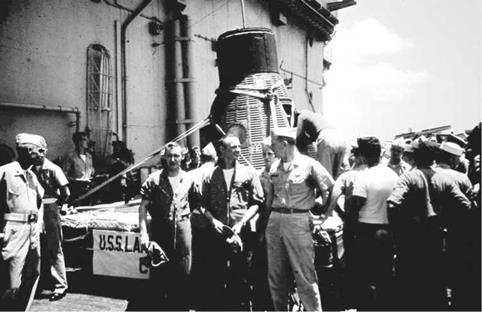CREWMEMBER MEMORIES
Marine PFC Paul Molnoski was on guard duty on the USS Lake Champlain during the entire recovery operation, and his account recalls the contingency procedures that people were to follow in the event that the astronaut was found dead or badly injured after splashdown. This was similar in some ways to the sorrowful speech President Richard Nixon would record in case the two Apollo 11 moonwalkers were stranded on the lunar surface.
As Molnoski explains, “I was assigned to the forward port-side of the flight deck, and was walking my post when I heard over the loudspeaker that the countdown was held at minus-15, just fifteen minutes before the scheduled time of the launching at 7.30 a. m. At about 9.30 it was reported that the rocket had been fired and, a minute later, that the Redstone Mercury missile was airborne. We were instructed that when the capsule hit, if he didn’t get out, Shepard would be presumed to be either dead or wounded. [The capsule] would be picked up by a Marine helicopter, brought aboard ship and taken down elevator number three. It would be opened and [Shepard] taken to sick bay. Only three persons beside the admiral would be allowed to speak to him; two doctors and one corps – man appointed by Washington. It would have been my job to clear the flight deck.
“No one was to cheer or try to talk with him when he came aboard ship. We heard his voice when he started reporting from the capsule. The first thing we heard was, ‘feel fine; nothing unusual has happened.’ I felt better then [because] I felt he would make it safely.
“I first spotted the capsule when it was about 4,000 feet up, descending under its parachute. He was six miles dead ahead of the ship. Three Marine and two Navy helicopters saw him. He hit the water about five or ten minutes later, surrounded by the ’copters. They had their hooks down and were ready to take him. When he hit the water, we waited for him to get out of the capsule. When he climbed out [and was hoisted] into the helicopter everyone was cheering. We felt great that he had made it. No one applauded or said anything when he came aboard, but everyone seemed to be taking pictures. He went right to the admiral’s cabin. I was just about ten feet from him. Our job continued until 5.00 a. m. the next morning. We stood guard over the capsule.” [42]
Anthony Vitulli was also on the ship that day. A 22-year-old graduate of the New York Institute of Photography, he was one of seven Navy photographers selected to document Shepard’s recovery and recalls the day with fondness. “I was standing on the 07 level [the seventh deck of the island] with a 4-by-5 camera and photographed the capsule as it came out of the sky. We could see it clearly – the landing was that accurate.” In addition to photographing the recovery, Vitulli also took pictures of the interior of Freedom 7 once it had been secured on deck. “It was cramped,” he said. “You look at that [capsule] and then you look at the [Space Shuttle] Enterprise and you say, ‘Oh! How can that be?’ The instruments were crude. You just can’t believe someone went up in space in something like that.” [43]
Prior to being assigned to the USS Lake Champlain, Michael Richmond had Navy recruit training at the Great Lakes Training Center on the shores of Lake Michigan, Illinois. He was part of the arresting gear handling crew – the cables and hardware used to arrest and rapidly slow the forward motion of a landing aircraft. When they
|
Air Officer Cdr. Howard Skidmore (right) with the Marine recovery pilots Wayne Koons and George Cox. (Photo courtesy of Ed Killian) |
knew they were going to recover the Freedom 7 spacecraft he and his crewmates had their cameras at the ready. “We went on the flight deck when they started bringing her in,” he recalls. They watched the sequence of events with interest until Shepard headed below for his health checkup, leaving his spacecraft behind. “That’s when we started taking pictures. They really didn’t make a big issue about security or guards. We just walked up to it and took pictures.” Like many other sailors, Richmond had a picture taken of himself proudly standing beside the history-making spacecraft [44].
Larry Kreitzberg from New York was a Navy photographer PH3 on board ship the day Shepard made his epic space flight. Several of his fine photographs appear in this book. As he explains, “I was assigned for this historic event to the 07 level of ‘The Champ’ along with several other ship’s photographers who were positioned in various parts of the ship as well as in two helicopters. With my aerial camera I was waiting anxiously to see Alan Shepard and his Mercury capsule, Freedom 7. This I consider to be the most exciting time I spent in the Navy.”
As the helicopter bearing its precious cargo approached the ship, “I looked down on the flight deck and observed the crew pointing upwards and watching the capsule being [lowered] on a frame covered with mattresses for cushioning. You could hear yelling and screaming as everyone was overcome with joy. I know I had tears in my eyes (which I’m not ashamed to say) along with everyone else. Watching Shepard depart the helicopter in his silver flight suit, smiling and waving, was one hell of a proud moment for all. I can say with pride that I was there for the first historic U. S. manned space flight with Commander Alan Shepard at the controls. That day is part of me and my life which I will never forget. A proud sailor, I was.” [45]











